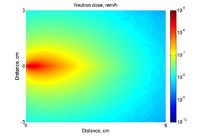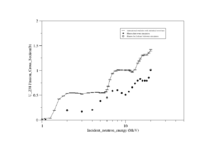Difference between revisions of "NNSA Center 2012"
| Line 40: | Line 40: | ||
{| border="1" |cellpadding="20" cellspacing="0 | {| border="1" |cellpadding="20" cellspacing="0 | ||
|- | |- | ||
| − | | | + | | Simulation|| Photon || neutron | proton |
|- | |- | ||
| − | | | + | | MCNPX |
| + | |- | ||
| + | | GEANT4 | 10 eV<math> \Rightarrow</math> 1 TeV | ||
|- | |- | ||
|} | |} | ||
Revision as of 00:36, 5 March 2012
They will support "development of advanced simulations and measurement techniques leading to improved radiation and particle detection methods in terms of energy, temporal and spatial resolution".
GEANT and MCNPX are two simulation packages commonly used by researchers in Nuclear physics to develop experiments and interpret experimental resuls. While GEANT4 is a publicly available open source package, MCNPX requires a license and may only be available as an executable to those who are not elibigle for a source license. GEANT and MCNPX have substantial overlap in the models and data they employ to predict how particles interact with matter. For example, both utilize the Evaluated Nuclear Data FIle (ENDF) from the National Nuclear Data Center as input to their simulation programs.
Historically, MCNPX has been a more complete resource for simulation nuclear reactions than GEANT. Recently however, GEANT4 has been gaining ground and becoming a testbed for such models as the Bertini Cascade model (INCL/ABLA). Although each has their stengths and weaknesses,
nuclear physics students who desire to develop a simulation program, but are not eligible for the MCNPX source code, rely on GEANT4. As a result, GEANT4 has a large development community and more readily used as an education tool for universities who train international students as well as
US students for entry into the US nuclear workforce.
Students working at the Idaho Accelerator Center have a long history of using MCNPX to interpret their experimental results. A recent effort has been made to begin using simulation tools in the design of experiments. Figure 1a is an example of using MCNPX to determine the neutron flux from a proposed accelerator based neutron source. Students in the center have been using GEANT4 to develop an efficient fission chamber. Figure 1b is an example of one student comparing the U-238 neutron induced fission spectrum predicted by the ABLA model in GEANT4 to the IAEA's data evaluation. As an NNSA center of excellence, students will be given the opportunity to contribute to the development of simulations by contrasting their predictions with experimental results.
 |

|
| a Neutron flux mapping for a tungsten cylindrical converter | b Comparing the U-238 neutron induced fission spectrum predicted by the ABLA model in GEANT4 to the IAEA's data evaluation |
INTERNATIONAL EVALUATION OF NEUTRON CROSS-SECTION STANDARDS, INTERNATIONAL ATOMIC ENERGY AGENCY,VIENNA, 2007 File:U238-xsection.pdf
absolute f_xsection in the table 7.1 p.91
Data set # 646 pr 648
646: Li Jingwen et al,INDC(CPR)-009 (1986) 7
648:R.K. Smith et al. (1956),Personal communication, G. Hanson (1975)
Table : energy range of interactions for photon neutron and proton.
| Simulation | Photon | proton |
| MCNPX | ||
| 10 eV 1 TeV |
There are several widely accepted Monte Carlo codes for radiation transport simulation. Some are well-documented and commonly used, others less well so. We are planning to use two such codes should the NNSA Center of Excellence be established: MCNPX and GEANT4. MCNPX is an acronym for Monte Carlo N-Particle EXtended. MCNPX tracks neutrons, photons, protons, electrons, alpha particles, and many more. It is commonly used in many fields of study where knowledge of how radiation interacts with matter is necessary. Common examples include nuclear fuel cycle research, nuclear criticality calculations, medical physics and radiography, isotope production, and detector development – an area we are planning to pursue mostly. A user has a great versatility in defining sources and materials, turning on and off different physics processes and choosing tallies to be performed. The energy range of different particles MCNPX tracks is shown in the Table 1. It can be extended by using physical cross-section models, such as Bertini or ISABEL.